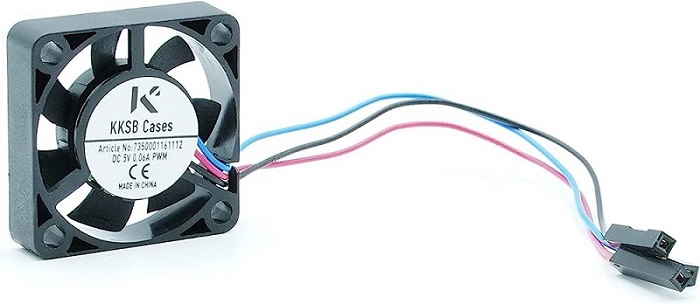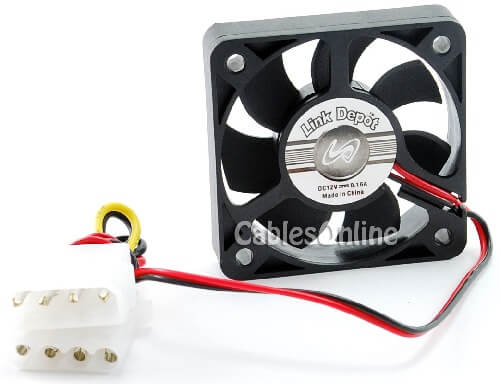Computer case fans are crucial in maintaining optimal airflow and cooling within a computer system. They help dissipate heat generated by various components, such as the CPU, graphics card, and power supply, preventing overheating. Effective cooling not only improves the overall performance and lifespan of the components but also ensures system stability. But to get the best cooling performance inside your case, you must also pick up the right fan for your system.
A few options are available for a PC case fan, such as standard, high airflow, static pressure, silent, RGB, etc. However, the overall functionality of the fans pretty much remains the same for all of these options.
The only case where you will find major changes in the design and connectivity of the fans is between the 3-pin fans and 4-pin fans. So today, we will compare both options in detail in our guide and check out the differences between them and see how they impact the performance and temperature level of the system.
Outline
ToggleWhat is a 3Pin Fan?

In contrast, the 12+ V pin is connected to the +12V power supply rail, providing the fan with the necessary voltage to operate. The 3rd pin is the tachometer pin, which provides feedback to the motherboard or fan controller about the fan’s speed. It sends pulses at a frequency proportional to the fan’s rotational speed, allowing the system to monitor and control its performance.
Since 3-pin fans do not have a dedicated pin for fan speed control, their speed is typically regulated by the motherboard or fan controller based on temperature readings from sensors on the system. The motherboard adjusts the voltage supplied to the fan to control its speed. You should also note that 3-pin fans generally have a simpler control mechanism than 4-pin fans.
What is a 4Pin Fan?

The primary difference between a 4-pin fan and a 3-pin fan lies in the fourth pin, the Pulse Width Modulation (PWM) pin. This pin allows for advanced speed control and more precise regulation of the fan’s RPM.
By utilizing PWM, the motherboard or fan controller can dynamically adjust the fan’s speed according to the system’s temperature or custom user-defined settings. PWM control sends rapid pulses of power to the fan, varying the duty cycle to determine the speed. This provides fine-grained control over the fan’s operation compared to simply varying the voltage as in a 3-pin fan.
The PWM control feature in 4-pin fans offers several advantages. First, it enables the fan to run at lower speeds, reducing noise levels and power consumption when cooling demands are lower. Second, it allows for more controlled temperature management, as the fan speed can be adjusted in real-time based on the system’s needs. Third, PWM fans are generally more responsive, capable of quickly ramping up or down their speed to adapt to changing conditions.
You should also know that 4-pin fans are backward compatible with 3-pin fan headers. So when connected to a 3-pin header, the fan will function as expected, but without the benefits of PWM control. It will operate at a fixed speed determined by the voltage supplied.
However, connecting a 4-pin fan to a 4-pin PWM header lets you use the full range of speed control options.
What are the Differences Between the 3-Pin and 4-Pin Fan?
When comparing 2 almost identical choices, such as a 3-pin fan and a 4-pin fan, checking out meter specification will not offer a satisfying answer. Instead, you should look into the broad aspect and applicability of the options and check out the factors which can impact the unit’s overall stability. In this section, we will compare 3-pin and 4-pin fans based on important factors such as PWM, noise, productivity, life expectancy, etc. With that, you can easily compare the options available and see which option benefits you the most.
1. PWM
Pulse width modulation or PWM control in 3-pin fans is achieved through voltage modulation. The motherboard or fan controller adjusts the voltage supplied to the fan to control its speed. The fan receives a varying voltage signal, which causes it to spin at different speeds. However, because PWM control is not directly supported by the 3-pin connector, this method is often called DC control since the fan is essentially reducing lesser power to operate at a slower speed and vice versa.
On the other hand, 4-pin case fans offer true PWM control. They have a dedicated fourth pin, specifically designed for PWM signals. Instead of modulating the voltage, the motherboard or fan controller adjusts the duty cycle of the PWM signal sent to the fan. The duty cycle represents the pulse duration ratio to the signal’s total period. The fan’s speed is controlled more precisely and flexibly by varying the duty cycle.
PWM-based 4-pin fans also provide finer speed resolution than 3-pin fans with DC control. This means that a wider range of speed adjustments can be achieved with PWM control. PWM fans can operate at very low speeds, making them more suitable for scenarios that require silent operation or efficient cooling under low-load conditions.
2. Noise
In case of noise, 4-pin fans with PWM control have an advantage over 3-pin fan options. PWM control allows for more precise speed adjustment and finer speed resolution than 3-pin fans using voltage control. As a result, 4-pin fans can operate at lower speeds, reducing noise levels when cooling demands are lower. This ability to run at lower speeds contributes to quieter operation.
PWM control also enables 4-pin fans to adjust their speed in response to changes in temperature dynamically. When the system is under minimal load or low ambient temperature, PWM fans can spin at slower speeds, generating less noise. As the cooling demands increase, the fan speed can be automatically increased to maintain optimal cooling performance. This dynamic adjustment helps keep noise levels in check while effectively cooling the system.
As opposed to that, 3-pin fans controlled via voltage modulation may produce some additional noise due to the nature of voltage-based speed control. When the voltage supplied to a 3-pin fan is reduced to decrease the speed, it can result in a small amount of electrical noise or coil whine. This noise is typically eliminated in 4-pin fans with PWM control.
3. Productivity
4-pin fans with PWM control offer more precise speed control than 3-pin fans with voltage control, thus allowing you to monitor and maintain the temperature of your system in real-time. The ability to adjust the fan speed dynamically allows for optimized cooling based on the system’s requirements. This can improve productivity by maintaining optimal operating temperatures for components such as the CPU and graphics card, enhancing performance and preventing thermal throttling.
Due to the finer speed resolution and dynamic speed adjustment capabilities offered by PWM control, 4-pin fans also have the potential to provide more efficient cooling in comparison. The ability to run at lower speeds during periods of lower cooling demands can help reduce noise levels and power consumption without compromising cooling performance. By maintaining optimal temperatures, 4-pin fans can contribute to stable system operation and prevent overheating-related performance issues without any additional noise.
4. Life Expectancy
The life expectancy of a fan is primarily determined by factors such as its build quality, bearing type, usage conditions, and maintenance required by the unit over a certain period of time. The pin configuration (3-pin or 4-pin) does not directly impact the fan’s life expectancy.
With that in mind, you should consider that the ability to adjust the fan speed dynamically based on temperature conditions can help optimize cooling performance and prevent excessive wear and tear on the 4-pin fans over extended periods. By operating at lower speeds during lower cooling demands, 4-pin fans can reduce mechanical stress and increase their lifespan.
The build quality of a fan, including the materials used and the manufacturing standards, directly impacts its longevity more than the pin configuration. Regardless of the pin configuration, higher-quality fans are generally designed to withstand prolonged use and have longer lifespans. When selecting a fan, it’s important to consider factors such as fan blade design, bearing type, and overall construction quality.
5. Compatibility
3-pin and 4-pin fans are compatible with 3-pin and 4-pin fan headers. The physical connectors of the fans and headers are designed to be compatible, allowing for easy installation and backward compatibility. When a 3-pin fan is connected to a 4-pin header, it will function without any issues.
The fan will receive power and operate at a fixed speed determined by the voltage supplied, as it doesn’t have access to PWM control. Likewise, 4-pin fans can be connected to 3-pin headers without any problems. In this case, the fan will still receive power and operate at a fixed speed determined by the voltage supplied. The fourth pin on the 4-pin fan connector, which is used for PWM control, will not be utilized when connected to a 3-pin header.
3 Vs 4 Pin Fans – FAQs
Ans: No, 3-pin fans do not necessarily run at full speed by default. The speed of a 3-pin fan is determined by the voltage supplied to it. The fan’s speed is directly proportional to the voltage it receives, where a higher voltage results in a faster spinning speed, and a lower voltage leads to a slower speed. The actual speed at which a 3-pin fan operates depends on the voltage provided by the fan header on the motherboard or fan controller. Most modern motherboards and fan controllers support voltage regulation, allowing you to control the speed of the 3-pin fan.
Ans: You can examine the fan’s connector to identify whether a fan is a 3-pin or 4-pin fan. If the fan’s connector has 3 metal pins, it is a 3-pin fan. But if you see an additional pin on the connector, you can conclude that it is a 4-pin fan with the fourth pin offered for PWM control. When examining the fan, look for the number of pins on the connector, and it can help you identify whether the fan is a 3-pin or 4-pin fan.
Ans: Yes, 4-pin fans can still work if connected to a 3-pin header. The physical connectors of 3-pin and 4-pin fans are compatible, allowing them to be connected interchangeably. When you connect a 4-pin fan to a 3-pin header, the fan will receive power and spin, functioning normally.
Ans: As we mentioned, both 3-pin fans and 4-pin fans are interchangeable, with 4-pin fans offering backward compatibility and 3-pin fans allowing basic fan operation without PWM support. So to answer your question, yes. 4-pin fans can be used in older motherboards with only 3-pin headers. When you connect a 4-pin fan to a 3-pin header on an older motherboard, the fan will still receive power and operate.
Conclusion
Today, we discussed the differences between 3-pin and 4-pin fans, including control mechanisms, noise, productivity, compatibility, and lifespan. We established that 3-pin fans operate using voltage control, while 4-pin fans offer the additional benefit of PWM control for more precise speed regulation.
Both fan types are compatible with 3-pin and 4-pin headers, allowing for flexibility in system compatibility. However, PWM functionality is not utilised when connecting 4-pin fans to 3-pin headers, resulting in fixed-speed operation.
While 4-pin fans provide advanced speed control and potential productivity gains, factors such as build quality, bearing type, usage conditions, and maintenance practices also play significant roles in a fan’s lifespan and performance. So, it is probably better to go with a 4-pin fan if you are choosing one for your case right now.

